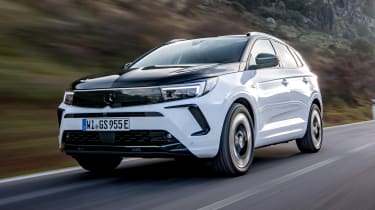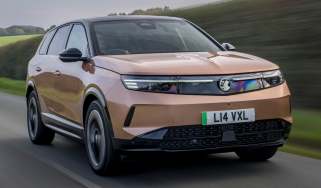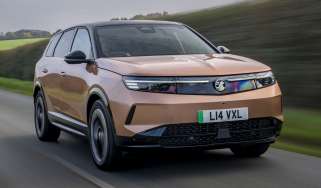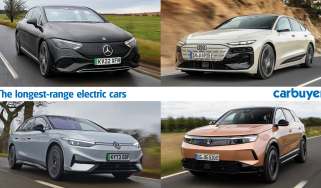Vauxhall Grandland (2017-2024) review - Engines, drive & performance
The Grandland is smooth and comfortable, but doesn’t offer as much fun as rivals
It's all too easy to get hung up on a car’s outright handling prowess, but there’s a strong argument to say buyers of family SUVs such as the Vauxhall Grandland are less concerned about this aspect of their cars than, say, owners of conventional hatchbacks and saloons.
Rather than being a driver-focused, sharp-handling SUV like the SEAT Ateca, the Grandland is a relaxed, comfortable and easy car in which to cover long distances. If that’s what you’re after, it could be the SUV for you. Further suspension tweaks for 2023 made the Grandland even better at coping with bumps, which is a welcome trait on British roads, even if it does lead to a bit more body lean than most rivals like the Mazda CX-5 and Cupra Ateca.
True, its light steering provides little feedback, but as a welcome flipside, it's an easy car to manoeuvre around town. The clutch is similarly effortless to operate, and although the gearbox provides little reward to those attempting quick, slick shifts, it's smooth enough if you take things a bit more calmly – although the brakes can feel a little grabby. This makes it tricky to gently draw up to a halt without passengers' heads nodding involuntarily.
More reviews
However, this relaxed nature becomes a problem in the high-performance Vauxhall Grandland GSe variant. While other hot SUVs such as the Cupra Formentor offer a driving experience similar to that of a nimble hot hatchback, the Grandland GSe feels uninspiring on a twisty road, unable to shake its near-1,900kg bulk. The benefit of all-wheel-drive traction is certainly welcome, however, the SUV’s numb steering makes it difficult to exploit the performance that’s on offer.
Other outright negatives remain slight and are easy to overlook; it's possible to detect a little wind noise around the door mirrors once up to cruising speed, for example, but this is partly because of the Grandland's otherwise hushed nature. Equally, while the slanting roofline has a knock-on effect where rear visibility is concerned, this is compensated for by the standard parking sensors and optional reversing camera.
Vauxhall Grandland petrol engine
The three-cylinder 1.2-litre 128bhp petrol engine offered with the Grandland is carried over from the Peugeot 3008. It's a smooth, punchy little engine, delivering more get-up-and-go than its small capacity might suggest. Going from 0-62mph takes 10.4 seconds (10.3 if you choose the automatic gearbox), we expect most buyers will find it to be the pick of the range.
On the road, the 1.2-litre engine has plenty of pulling power when mated to a six-speed manual gearbox. When accelerating, it gets up to speed quickly without ever feeling strained, and is flexible with ample power for overtaking manoeuvres. The gearbox is precise and feels slick to use, and refinement is good, with only a small amount of engine noise noticeable from the driver’s seat.
The 1.2-litre Grandland Hybrid has slightly more power, a 10-second 0-62mph time and it’s even better to drive. While the old petrol automatic was frustrating to drive with brakes, gear changes and stop-start tech that made for a jerky experience, the Hybrid’s small electric motor makes it much smoother at getting up to speed.
A larger, four-cylinder 1.6-litre petrol producing 178bhp was previously available in the range-topping Ultimate trim level, offering a significant power increase over the base engine. Discontinued for the facelifted version, it was only available with an automatic gearbox and delivered the best performance of the regular Grandland X lineup, getting the car from 0-62mph in 8.3 seconds.
Diesel engine
If you need a diesel, don't be put off: the 1.5-litre engine offered with the Grandland promises impressive economy, and it's a fair increase in performance over the 1.6-litre unit it replaced. It has enough pulling power that you never really need to rev it to the point that it gets overly noisy, and it's very quiet at motorway speeds. With 129bhp at its disposal, the Grandland diesel will reach 62mph in 12.3 seconds, with help from its standard eight-speed automatic gearbox.
Hybrid engines
As part of the facelift in 2021, the Grandland X Hybrid and Hybrid4 models were replaced by a single variant: the Grandland Hybrid-e. It combines a 1.6-litre petrol engine, an electric motor and a 13.2kWh battery, producing a total power output of 222bhp.
Power is sent to the front wheels via an eight-speed automatic gearbox, and this is now the only PHEV offered in the facelifted Grandland at launch. It can still get from rest to 62mph in 8.9 seconds, making it roughly as quick as most 2.0-litre diesel SUVs.
It's possible to drive at up to 83mph in EV mode, but when the petrol engine springs to life it's reasonably smooth and quiet at urban speeds. Pick up the pace, and the petrol can sound somewhat strained, while we also found the eight-speed automatic can struggle to find the right ratio.
Offering even more punch is the 296bhp plug-in Grandland GSe; billed as a performance SUV to rival the Volkswagen Tiguan R, this gets from 0-62mph in an impressive 6.1 seconds, thanks to all-wheel-drive grip. Unfortunately, like the standard PHEV, the gearbox tends to fumble around once you put your foot down and it doesn’t sound anywhere near as good as a hot hatch such as the Hyundai i30N.
Which Is Best?
Cheapest
- Name1.2 Hybrid 145 Design 5dr e-DCT6
- Gearbox typeAuto
- RRP£36,370
Most Economical
- Name1.2 Hybrid 145 Design 5dr e-DCT6
- Gearbox typeAuto
- RRP£36,370
Fastest
- Name1.2 Hybrid 145 Design 5dr e-DCT6
- Gearbox typeAuto
- RRP£36,370















